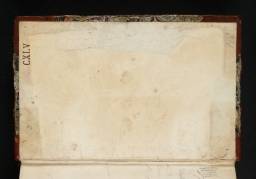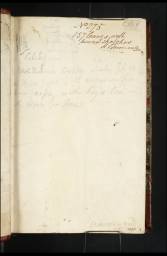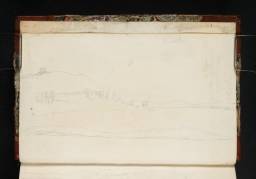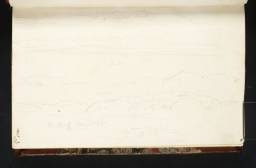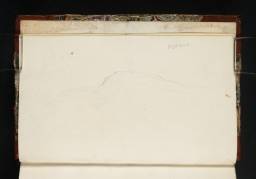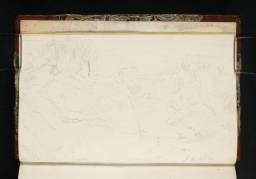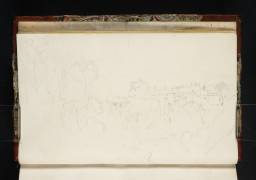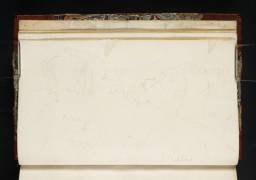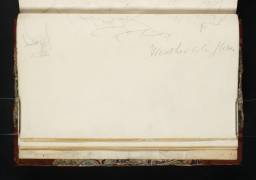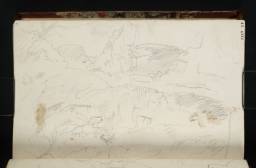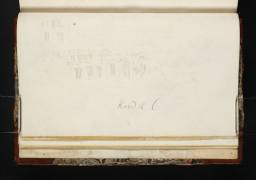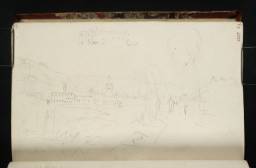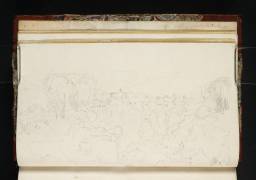Turner Bequest CXLV 1–187
Small, thick notebook half-bound in boards, covered in green and red marbled paper, with chestnut leather corners and spine; spine cloth restored
187 leaves of white wove paper; page size 154 x 96 mm
Made by Joseph and Elizabeth Smith at Dursley Mill, Gloucestershire; various leaves watermarked ‘I & E Smith 1812’
Trade label of Mills & Sons, Booksellers of Oxford Street affixed inside the back (presumably original front) cover (D40845); for the sketchbook’s ‘front’ and ‘back’ as since foliated contrary to Turner’s itinerary, see main catalogue entry
Inscribed by Turner in ink ‘Yorkshire 2’ (now very rubbed, and not distinctly legible) towards top of front cover (D40844)
Numbered 275 as part of the Turner Schedule in 1854 and endorsed by the Executors of the Turner Bequest on folio 1 recto (D11042)
Blind-stamped with Turner Bequest monogram on spine cloth towards top left of front cover
Stamped in brown ‘CXLV’ bottom right of front cover, upside down
187 leaves of white wove paper; page size 154 x 96 mm
Made by Joseph and Elizabeth Smith at Dursley Mill, Gloucestershire; various leaves watermarked ‘I & E Smith 1812’
Trade label of Mills & Sons, Booksellers of Oxford Street affixed inside the back (presumably original front) cover (D40845); for the sketchbook’s ‘front’ and ‘back’ as since foliated contrary to Turner’s itinerary, see main catalogue entry
Inscribed by Turner in ink ‘Yorkshire 2’ (now very rubbed, and not distinctly legible) towards top of front cover (D40844)
Numbered 275 as part of the Turner Schedule in 1854 and endorsed by the Executors of the Turner Bequest on folio 1 recto (D11042)
Blind-stamped with Turner Bequest monogram on spine cloth towards top left of front cover
Stamped in brown ‘CXLV’ bottom right of front cover, upside down
Accepted by the nation as part of the Turner Bequest 1856
Exhibition history
References
This sketchbook is an example of the kind of small, thick pocket book that Turner often carried with him on major tours to use for jottings and the initial exploration of sites. It was used in conjunction with the Yorkshire 4 sketchbook (Tate; Turner Bequest CXLVII) and Yorkshire 5 sketchbook (Tate; Turner Bequest CXLVIII) on a tour of Yorkshire and north Lancashire in the summer of 1816, to collect material for a series of commissioned illustrations for a proposed seven-volume General History of the County of York by Thomas Dunham Whitaker (see the Introduction to the present tour).1
The book contains the most detailed record of his itinerary between 17 July and 11 August 1816 (see notes on dating below). Turner set out from Farnley Hall, the seat of his Yorkshire patron Walter Fawkes, and travelled via Skipton to Browsholme Hall in Lancashire, where he stayed for a week. The sketches begin at Skipton and continue around the Browsholme area. He then went from Browsholme to Malham and Gordale, where the sketches continue, and struck off in wet weather into upper Wharfedale, Wensleydale and Swaledale, reaching Richmond on 31 July. From there he continued north via Aske Hall and Rokeby into Teesdale and then crossed the high Pennine moors to Appleby in Westmorland. From there he headed south-west to the Kendal area and then explored the north shore of Morecambe Bay before crossing the sands to Lancaster. From there he followed the river Lune north-east to Kirkby Lonsdale, before returning to Farnley Hall via Skipton.
Following this itinerary in the sketchbook is complicated a little by the fact that Finberg’s 1909 Inventory numbered the pages in reverse order,2 as reflected in the foliation here. The proper orientation of the book is, however, established by the bookseller’s label inside what must have been the front cover (D40845; now at the ‘back’ as foliated). It should be noted that Turner began by entering his sketches with what he regarded as the front cover to the left, or towards the top, and continued in that manner with only a few exceptions up to the rough halfway point of the book, whereupon (starting with the sketch of Heysham Head on folio 80 verso; D11164) he turned the book around and continued through the remainder of his itinerary, again with a few exceptions, entering sketches in the reverse orientation. Turner presumably found this way of working most comfortable and convenient. For comments on Turner’s inscription, ‘Yorkshire 2’, on the ‘front’ cover as foliated, see under D40884.
This sketchbook contains clear documentary evidence for dating. A list by Turner of banknotes on folio 187 verso (D11370) itemises several dated May and June 1816 and notes the places at which they were enchashed, including Greta Bridge, Lancaster and Askrigg. Further, it is known from the diaries of Maria Sophia, the wife of Walter Fawkes, extracts from which were published by Finberg3 and utilised by the present author,4 that the Fawkes party, accompanied by Turner, left Farnley on 17 July 1816 and travelled via Skipton to Browsholme Hall in Lancashire. They stayed until 24 July when they left and travelled to Malham, and on the next day visited nearby Gordale Scar, before parting from Turner who went off, so it is recorded, ‘on a sketching tour’.
The Yorkshire 2 sketchbook begins with and follows every aspect of that early itinerary, and then charts the whole of the subsequent tour. Sketches in the Yorkshire 4 and Yorkshire 5 books, which may also be dated 1816 by association, closely mirror the itinerary documented by the sketches. Turner wrote a letter from Richmond in Yorkshire on 31 July 1816,5 which dates the sketches in that area, and from internal indications such as times of day indicated by shadows, the present author proposed a day-by-day dating of the sketches up to Turner’s return to Farnley in time for the opening of the shooting season on 12 August.6
Technical notes
How to cite
David Hill, ‘Yorkshire 2 Sketchbook 1816’, sketchbook, April 2009, revised by Matthew Imms, May 2019, in David Blayney Brown (ed.), J.M.W. Turner: Sketchbooks, Drawings and Watercolours, Tate Research Publication, March 2023, https://www


